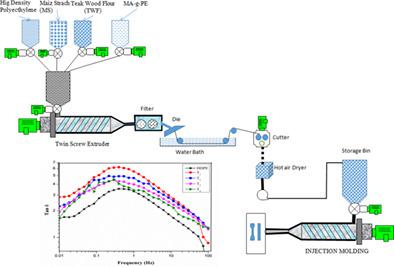当前位置:
X-MOL 学术
›
J. Appl. Polym. Sci.
›
论文详情
Our official English website, www.x-mol.net, welcomes your
feedback! (Note: you will need to create a separate account there.)
Rheological properties of teak wood flour reinforced HDPE and maize starch composites
Journal of Applied Polymer Science ( IF 2.7 ) Pub Date : 2020-09-15 , DOI: 10.1002/app.49874 Kishor Biswas 1 , Vinay Khandelwal 2 , Sourindra Maiti 3
Journal of Applied Polymer Science ( IF 2.7 ) Pub Date : 2020-09-15 , DOI: 10.1002/app.49874 Kishor Biswas 1 , Vinay Khandelwal 2 , Sourindra Maiti 3
Affiliation

|
Teak wood flour reinforced high density polyethylene and maize starch composites were prepared by using maleic anhydride grafted polyethylene as a compatibilizer. The mechanical properties (tensile and flexural) of all the composites increased after addition of 10%–40% teak wood flour into HDPE matrix. The complex viscosity (η*) was higher for all the composites at the low frequency, but decreased with increasing frequencies indicating a shear thinning behavior of the composites. The storage modulus and loss modulus increased for the composites compared to the HDPE at low frequencies. Damping factor peak of HDPE and composites showed high below 1 Hz, but the peak start decreasing with increasing above 1 Hz. The relaxation behavior of HDPE and the composites after incorporating teak wood flour, maize starch, and compatibilizer was obtained by Han plot. Biodegradability was enhanced with the incorporation of teak wood flour, maize starch into the composites. Appreciable water uptake and the thickness swelling for the composites indicating it's potential for interior, automobile and packaging applications.
中文翻译:

柚木木粉增强HDPE和玉米淀粉复合材料的流变性能
柚木粉增强高密度聚乙烯和玉米淀粉复合材料是通过使用顺丁烯二酸酐接枝的聚乙烯作为增容剂来制备的。在HDPE基质中添加10%–40%柚木粉后,所有复合材料的机械性能(拉伸和弯曲)均提高。所有复合材料的复数粘度(η*)在低频下都较高,但随着频率的增加而降低,表明复合材料的剪切稀化行为。与HDPE在低频下相比,复合材料的储能模量和损耗模量增加。HDPE和复合材料的阻尼因子峰值在1 Hz以下显示较高,但在1 Hz以上则开始减小。掺入柚木粉,玉米淀粉,HDPE和复合材料后的松弛行为 并通过汉积获得相容剂。通过将柚木粉,玉米淀粉掺入复合材料,可生物降解性得到增强。复合材料的明显吸水率和厚度膨胀表明它在室内,汽车和包装应用中具有潜力。
更新日期:2020-11-17
中文翻译:

柚木木粉增强HDPE和玉米淀粉复合材料的流变性能
柚木粉增强高密度聚乙烯和玉米淀粉复合材料是通过使用顺丁烯二酸酐接枝的聚乙烯作为增容剂来制备的。在HDPE基质中添加10%–40%柚木粉后,所有复合材料的机械性能(拉伸和弯曲)均提高。所有复合材料的复数粘度(η*)在低频下都较高,但随着频率的增加而降低,表明复合材料的剪切稀化行为。与HDPE在低频下相比,复合材料的储能模量和损耗模量增加。HDPE和复合材料的阻尼因子峰值在1 Hz以下显示较高,但在1 Hz以上则开始减小。掺入柚木粉,玉米淀粉,HDPE和复合材料后的松弛行为 并通过汉积获得相容剂。通过将柚木粉,玉米淀粉掺入复合材料,可生物降解性得到增强。复合材料的明显吸水率和厚度膨胀表明它在室内,汽车和包装应用中具有潜力。









































 京公网安备 11010802027423号
京公网安备 11010802027423号